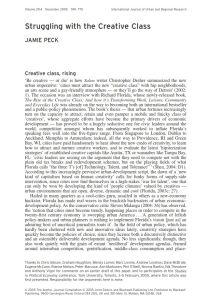Зарегистрируйтесь на getAbstract, чтобы получить доступ к этому краткому изложению.

Зарегистрируйтесь на getAbstract, чтобы получить доступ к этому краткому изложению.
Jamie Peck
Struggling with the Creative Class
Blackwell Publishing Ltd., 2005
Что внутри?
Around the world, civic leaders are fighting to attract and retain the emerging “creative class.”
Recommendation
Around the world, civic leaders are fighting to attract and retain creative people. Never before has human creativity been considered so valuable for economic growth, making creative people an emerging, elitist group in society. In this paper, geography professor Jamie Peck analyzes urban-studies theorist Richard Florida’s thesis that the people who make up the “creative class” are the new “primary drivers of economic development” and that cities should do all they can to attract them. getAbstract recommends this comprehensive, though somewhat verbose, discussion to town planners, civic leaders, creative people, and anyone interested in current urban trends and development.
Summary
About the Author
Jamie Peck is Canada research chair in urban and regional political economy and a geography professor at the University of British Columbia.


















Comment on this summary